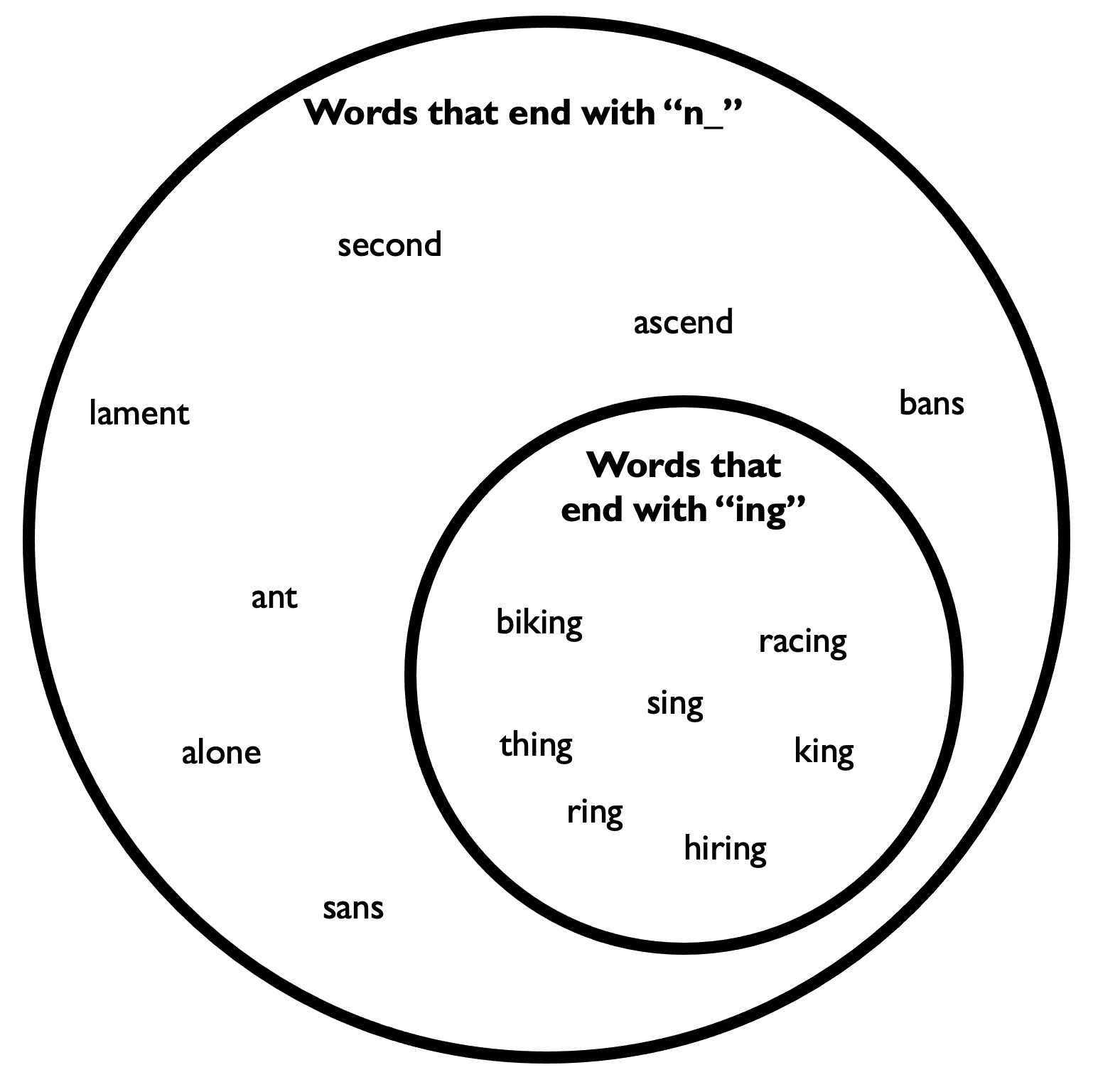Which of these is more common in the English language:
A) words that end in “ing”
B) words with “n” as the second to last letter?
It might be tempting to pick A. There are lots of verbs that come easily to mind that end in “ing” (racing, baking, typing, etc.)—not to mention nouns like king, ring, wing etc. By contrast, it might seem harder to think of words with “n” as the second to last letter (besides, well, “second”). But in reality, the answer is B, for one simple reason: every word that ends in “ing” must—by definition—also have “n” as the second to last letter—but not every word with “n” as the second to last letter ends in “ing.”

If you picked A, you committed something called the conjunction fallacy. This fallacy occurs when people assume that a combination of multiple events (e.g., a word with “i” as the third to last letter, “n” as the second to last letter, and “g” as the last letter) is more likely than just one of the events by itself (a word with n as the second to last letter). As we see in the image above—this assumption is mathematically impossible.
If you did make this error, don’t be disheartened. It’s a pretty common mistake for people to make, and it may reflect a fundamental aspect of human reasoning—that we often use mental shortcuts to make inferences about complex problems. But is this fallacy just an aspect of human reasoning, or might we have this in common with nonhuman animals as well?
In a recent paper in Psychonomic Bulletin & Review, researchers Valeria V. González, Sowgol Sadeghi, Linh Tran & Aaron P. Blaisdell (pictured below) addressed this question, examining whether rats—like humans—can commit the conjunction fallacy.

Studying the conjunction fallacy in rats requires a bit of innovation. It goes without saying that you can’t just give a rat a word problem and have them indicate their response by speaking, writing, or pulling on your hair. So to examine how rats reason, the authors examined their food-seeking behavior.

The basic paradigm involves two sounds: sound A and sound B. During an initial set of training sessions, rats were trained to learn that pressing a lever would often release food when sound B was played, but not sound A. There were also two visual cues presented on a lightbulb: light X and light Y. When these lights were paired with the sounds, they flipped the sound’s original meaning. That is, when light Y was paired with sound B, pressing the lever would no longer release food. Similarly, when light X was paired with sound A, pressing the lever would release food.
After receiving this training, the rats were tested. On some test trials, rats only heard sound A or B with the lightbulb off. Based on how they were trained, the rats should pretty clearly press the lever more for sound B than sound A, because—when the light was off—they only ever received food when they heard sound B. Critically, on other test trials, the lightbulb was occluded from the rats’ view by a metal shield. This condition can give insight into what rats think is likely going on. When they hear a given sound, do they react like the light is likely on, likely off, or equally likely to be either?

Interestingly, the rats seemed to react like they “believed” the light was likely on. Recall that the rats learned that the presence of a light flipped the meaning of the sound. So, if the light is actually present, rats should be more likely to press the lever to receive food when hearing sound A than sound B. Indeed, this is just how the rats responded when the light was hidden.
Thus, as the authors of the featured article show, even rats show the conjunction fallacy. The rats “believed” that two events together (a sound and light) were more likely than just one (the sound). This finding goes against theories of the effect that suggest it requires specialized reasoning faculties around social information—the kind of faculties that only humans would have.
Instead, the authors suggest that the conjunction fallacy may sometimes be committed due to much more general, basic aspects of reasoning. For instance, humans and nonhuman animals alike may be biased to “fill in missing information” in order to reason about their environments, producing errors like the conjunction fallacy shown here. As the authors state:
In nature, organisms typically don’t have access to all the relevant information about a situation in which a decision is being made. It is possible there are heuristic biases to believe something is present (i.e., fill in missing information) when only partial information is available (e.g., a lion only sees the head of the antelope above the tall grass; a squirrel only sees part of a nut covered by leaves; etc.). If humans and other animals create partial simulations to facilitate decision making, we might expect systematic biases, such as the conjunction fallacy.
Of course, there are many differences between how humans and rats think and reason. But now we know that being able to fall prey to the conjunction fallacy is not one of them.
Featured Psychonomic Society Article
González, V. V., Sadeghi, S., Tran, L., & Blaisdell, A. P. (2023). The conjunction fallacy in rats. Psychonomic Bulletin & Review, 1-11. https://doi.org/10.3758/s13423-023-02251-z
